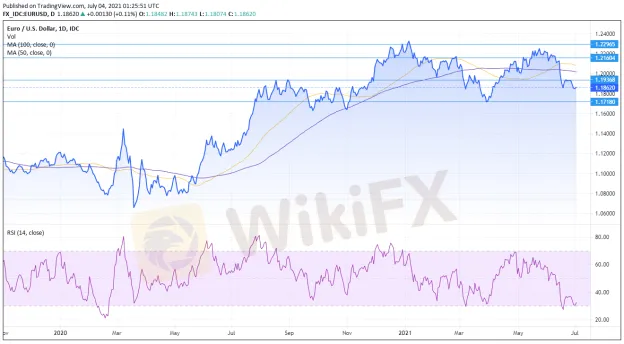简体中文
繁體中文
English
Pусский
日本語
ภาษาไทย
Tiếng Việt
Bahasa Indonesia
Español
हिन्दी
Filippiiniläinen
Français
Deutsch
Português
Türkçe
한국어
العربية
EUR-USD Forecast – Weekly: 5th – 9th July
Abstract:The crucial publication looks to have had one specific aim in markets – activating a bearish dollar retracement. The United States increased jobs than projected, 850k. Though, a modest wage advance at 3.6% and the absence of significant bullish retracement are sufficient to induce a bullish advance.

EUR-USD daily chart for the month of July shows bulls is in charge.
The crucial publication looks to have had one specific aim in markets – activating a bearish dollar retracement. The United States increased jobs than projected, 850k. Though, a modest wage advance at 3.6% and the absence of significant bullish retracement are sufficient to induce a bullish advance.
Ahead of a long weekend, traders had many positions close. Nevertheless, EUR-USD stays bearish still on the weekly chart.

Coming week events in the US
Resonances from Friday's Nonfarm Payrolls data will probably impact markets in the early days of the week while Americans maximize their long weekend. Supplementary analysis could influence stockholders to alter their positions. Coming Tuesday, the ISM Services PMI figures for June take over the spotlight, ready to ease from the high level of 64 issued in May.
While the employment section in ISM's statement is to some extent musty second to the NFP, the Prices Paid data is pertinent to the Fed's valuation of inflation prospects.
On Wednesday, the central bank stays in focus, with the issuance of its June meeting minutes. That event manifests a variation point for the dollar, as the Federal Reserve surprised traders with a bullish drift. The plot gestured two interest rate hikes in 2023, and Chair J. Powell proceeded by stating that the argument about narrowing bond-buying is taking off.
EUR-USD Technical Overview
EUR-USD is moving closer towards oversold settings as indicated by the Relative Strength Index of the daily chart. If the RSI plunges beneath 30, the pair could retrace upward. Other pointers as momentum and the 50-day, 100-day, and 200-day Simple Moving Averages all indicate a bearish trend in the long run.
At the early July low of 1.1835 is a support area, shadowed by 1.1760, a pad back in late March. Afterward, the round 1.17 level – EUR-USD launch point in 1999 – is the next line to pay attention to.
At 1.1910 is a resistance area, a former support line from late June. It is ushered by 1.1970, the post-Fed bearish recovery zenith. A persevering lid seats at 1.20, which is not only a mental obstacle but also a support line from May and where the 200-day SMA intersects the price.

EUR-USD Sentimental Overview
The Fed's statement may help as a reminder of the bank's hawkish shift, which could counter a dovish move from the ECB. The spread of the Delta variant across Europe could impact the euro. Above all, there is room for more bears.

Disclaimer:
The views in this article only represent the author's personal views, and do not constitute investment advice on this platform. This platform does not guarantee the accuracy, completeness and timeliness of the information in the article, and will not be liable for any loss caused by the use of or reliance on the information in the article.
Read more

Trading Psychology – 4 Wise Quotes From The Legendary Mark Douglas
In the world of trading, few books have had the impact of Mark Douglas’ big hit Trading in the Zone. Written almost two decades ago, the book has become a must-read for traders looking to elevate their game to legendary status. While there is so much wisdom to be found in the book, we’ve compiled 5 of the best quotes about trading psychology that every trader should read.

EUR/USD Forecast: New lows ahead of the weekend? ECB, covid and technical all point lower.
Optimism has been weighing on the safe-haven dollar – but not against the euro. The common currency's failure to recover is a sign of weakness that could be followed with falls to fresh lows once the mood sours again – and there are reasons to expect that to happen sooner rather than later.

EURJPY WEEKLY FORECAST. Price Likely To Rise Above 131.000.
The price of EURJPY has been on a steady rise ever since it made a low of 128.808. Other currencies collapsed against the Japanese Yen two weeks ago.

AUD Is Weak Under All-rounded Pressure
A rise in the wake of a fall was seen by DXY last week ascribed to the uncertain time of delisting caused by the Federal Reserve (Fed). However, the reason for the rally of DXY last Friday is the vigorous growth of personal consumption expenditures (PCE) released by the U.S. Bureau of Economic Analysis (BEA).
WikiFX Broker
Latest News
Spotware Unveils cTrader Store, Global Marketplace for Algo Creators
Elderly Trader Loses RM2.1M in WhatsApp Forex Scam
Gigamax Scam: Tracking Key Suspects in RM7 Million Crypto Fraud
CFI Partners with MI Cape Town, Cricket Team
Doo Financial Expands Reach with Indonesian Regulatory Licenses
WikiFX Review: Is IQ Option trustworthy?
5 Questions to Ask Yourself Before Taking a Trade
Quadcode Markets: Trustworthy or Risky?
Avoid Fake Websites of CPT Markets
Webull Canada Expands Options Trading to TFSAs and RRSPs
Currency Calculator


